(八)内置Attribute功能列表
__attribute__用法

__attribute__用法__attribute__是GCC编译器提供的一种语法扩展,用于指定变量、函数、结构体等的属性。
通过__attribute__可以告诉编译器一些额外的信息,从而优化代码或生成更好的代码。
下面是一些常用的__attribute__用法:1. __attribute__((packed))这个属性告诉编译器取消结构体中成员之间的内存对齐,使得结构体的大小最小。
这个属性通常用于网络编程中,将数据封装成二进制流传输时可以减小数据的大小。
示例代码:struct __attribute__((packed)) Person {char name[20];int age;};2. __attribute__((noreturn))这个属性用于告诉编译器函数不会返回,比如exit函数和abort 函数。
这样编译器就可以在函数调用点后面省略一些代码,以提高程序运行效率。
示例代码:void __attribute__((noreturn)) my_exit(int status) {// 执行一些清理工作exit(status);}3. __attribute__((aligned(n)))这个属性告诉编译器变量需要按照n字节对齐。
n必须是2的幂,通常是2、4、8或16字节。
这个属性可以用于优化内存访问的效率,但是会增加内存的消耗。
示例代码:int __attribute__((aligned(16))) a[4];4. __attribute__((section('name')))这个属性用于将变量或函数放到指定的段(section)中。
段是一种内存区域,程序在运行时可以根据需要将段加载到内存中。
这个属性通常用于嵌入式系统的开发,可以将一些特定的代码和数据放到特定的段中,以便于管理和使用。
示例代码:int __attribute__((section('mysect'))) b;5. __attribute__((weak))这个属性用于将函数或变量声明为弱符号。
attribute 用法 section 部分

attribute 用法section 部分1. gcc的__attribute__编译属性要了解Linux Kernel代码的分段信息,需要了解一下gcc的__attribute__的编绎属性,__attribute__主要用于改变所声明或定义的函数或数据的特性,它有很多子项,用于改变作用对象的特性。
比如对函数,noline将禁止进行内联扩展、noreturn表示没有返回值、pure表明函数除返回值外,不会通过其它(如全局变量、指针)对函数外部产生任何影响。
但这里我们比较感兴趣的是对代码段起作用子项section。
__attribute__的section子项的使用格式为:__attribute__((section("section_name")))其作用是将作用的函数或数据放入指定名为"section_name"输入段。
这里还要注意一下两个概念:输入段和输出段输入段和输出段是相对于要生成最终的elf或binary时的Link过程说的,Link过程的输入大都是由源代码编绎生成的目标文件.o,那么这些.o 文件中包含的段相对link过程来说就是输入段,而Link的输出一般是可执行文件elf或库等,这些输出文件中也包含有段,这些输出文件中的段就叫做输出段。
输入段和输出段本来没有什么必然的联系,是互相独立,只是在Link过程中,Link程序会根据一定的规则(这些规则其实来源于Link Script),将不同的输入段重新组合到不同的输出段中,即使是段的名字,输入段和输出段可以完全不同。
其用法举例如下:int var __attribute__((section(".xdata"))) = 0;这样定义的变量var将被放入名为.xdata的输入段,(注意:__attribute__这种用法中的括号好像很严格,这里的几个括号好象一个也不能少。
)static int __attribute__((section(".xinit"))) functionA(void){.....}这个例子将使函数functionA被放入名叫.xinit的输入段。
__attribute__详解及应用

__attribute__详解及应⽤之前做过App的启动优化,遇到了+load优化的问题,后来想⼀想除了initializers代替+load还有没有什么好的⽅法,然后就搜到了运⽤编译属性__attribute__优化,于是查找了很多⽂章,系统的整理了下__attribute__。
本⽂⼤部分内容来⾃引⽤的⽂章,如果想看更多更详细内容可以查看引⽤⽂章。
__attribute__ 介绍__attribute__是⼀个编译属性,⽤于向编译器描述特殊的标识、错误检查或⾼级优化。
它是GNU C特⾊之⼀,系统中有许多地⽅使⽤到。
__attribute__可以设置函数属性(Function Attribute )、变量属性(Variable Attribute )和类型属性(Type Attribute)等。
__attribute__ 格式12__attribute__ ((attribute-list))__attribute__ 常⽤的编译属性及简单应⽤format这个属性指定⼀个函数⽐如printf,scanf作为参数,这使编译器能够根据代码中提供的参数检查格式字符串。
对于追踪难以发现的错误⾮常有帮助。
format参数的使⽤如下:1format (archetype, string-index, first-to-check)第⼀参数需要传递archetype指定是哪种风格,这⾥是 NSString;string-index指定传⼊函数的第⼏个参数是格式化字符串;first-to-check指定第⼀个可变参数所在的索引.C中的使⽤⽅法12extern int my_printf (void *my_object, const char *my_format, ...) __attribute__((format(printf, 2, 3)));在Objective-C 中通过使⽤__NSString__格式达到同样的效果,就像在NSString +stringWithFormat:和NSLog()⾥使⽤字符串格式⼀样1 2 3FOUNDATION_EXPORT void NSLog(NSString *format, ...) NS_FORMAT_FUNCTION(1,2); + (instancetype)stringWithFormat:(NSString *)format, ... NS_FORMAT_FUNCTION(1,2);__attribute__((constructor))确保此函数在在main函数被调⽤之前调⽤,iOS中在+load之后main之前执⾏。
vba attribute语法
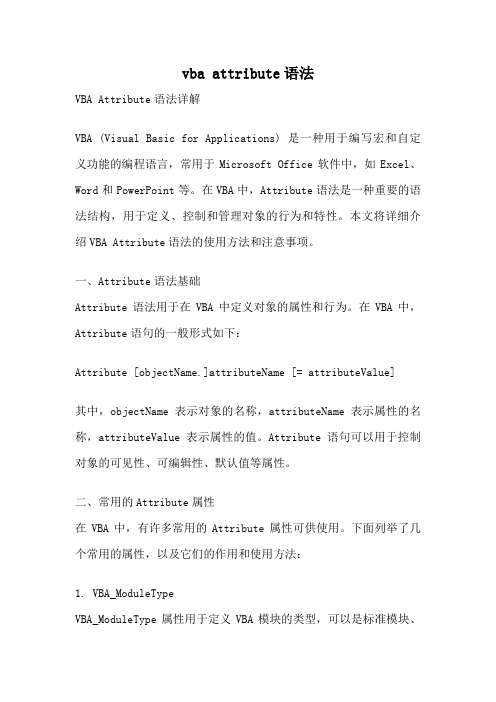
vba attribute语法VBA Attribute语法详解VBA (Visual Basic for Applications) 是一种用于编写宏和自定义功能的编程语言,常用于Microsoft Office软件中,如Excel、Word和PowerPoint等。
在VBA中,Attribute语法是一种重要的语法结构,用于定义、控制和管理对象的行为和特性。
本文将详细介绍VBA Attribute语法的使用方法和注意事项。
一、Attribute语法基础Attribute语法用于在VBA中定义对象的属性和行为。
在VBA中,Attribute语句的一般形式如下:Attribute [objectName.]attributeName [= attributeValue]其中,objectName表示对象的名称,attributeName表示属性的名称,attributeValue表示属性的值。
Attribute语句可以用于控制对象的可见性、可编辑性、默认值等属性。
二、常用的Attribute属性在VBA中,有许多常用的Attribute属性可供使用。
下面列举了几个常用的属性,以及它们的作用和使用方法:1. VBA_ModuleTypeVBA_ModuleType属性用于定义VBA模块的类型,可以是标准模块、类模块或用户窗体模块。
例如,可以使用以下代码将一个模块定义为类模块:Attribute VB_ModuleType = VB_ClassModule2. VBA_HelpFileVBA_HelpFile属性用于指定VBA代码的帮助文件。
通过设置此属性,可以为VBA代码提供详细的帮助信息。
例如,可以使用以下代码指定一个帮助文件:Attribute VB_HelpFile = "C:\HelpFile.chm"3. VBA_ExposedVBA_Exposed属性用于控制VBA代码是否对外部调用可见。
attribute用法 c语言

attribute用法 c语言在C语言中,attribute是一种用于向编译器提供额外信息的特殊修饰符,可以用于变量、函数、类型、代码段等的声明。
attribute的使用方式为在声明之前加上__attribute__((attribute_list)),其中attribute_list可以是一个或多个attribute的组合。
下面是一些常见的attribute及其用法:1. __attribute__((aligned(n))): 指定变量或类型的对齐方式为n 字节对齐。
例如,__attribute__((aligned(4)))会将变量对齐到4字节边界。
2. __attribute__((packed)): 指定结构体或联合体的对齐方式为紧凑对齐,即取消对齐填充字节。
例如,__attribute__((packed))会取消结构体的字节对齐。
3. __attribute__((noreturn)): 声明函数不会返回,用于避免编译器产生警告或优化错误。
例如,void my_func()__attribute__((noreturn)); 声明my_func函数不会返回。
4. __attribute__((format(printf, m, n))): 声明函数的参数和返回值按照printf风格格式化输出,其中m表示参数从第m个开始为格式化字符串,n表示参数从第n个开始为变量参数。
5. __attribute__((unused)): 声明变量或函数未使用,用于避免编译器产生警告。
例如,int my_var __attribute__((unused)); 声明my_var变量未使用。
6. __attribute__((section("name"))): 指定变量或函数所在的代码段或数据段的名称为name。
例如,int my_var__attribute__((section("my_section"))); 将my_var变量放入名为my_section的代码段。
gd32单片机attribute用法

gd32单片机attribute用法神州数码GD32系列微控制器是由中国的神州数码科技有限公司开发和生产的一类全新的高性能芯片。
其中,attribute(属性)是GD32单片机开发中非常重要的一个关键词。
在本文中,我们将详细介绍GD32单片机attribute的用法,并从基本概念到具体实现进行一步一步的回答。
第一部分:attribute的基本概念在GD32单片机开发中,attribute是一种用于对变量、函数或整个文件进行属性修饰的关键字。
它可以用于指定编译器的行为,以达到优化代码、控制内存布局、调整函数入口等目的。
attribute的语法形式一般为:__attribute__((属性名称))。
在attribute中,属性名称可以用来控制编译器的行为,例如:1. 优化属性:常用的优化属性有inline、noinline、always_inline等。
其中,inline表示将函数作为内联函数进行编译,noinline表示禁止将函数进行内联优化,always_inline表示强制将函数作为内联函数进行编译。
2. 引用属性:常用的引用属性有weak、alias等。
其中,weak表示变量或函数是弱符号,即可以被覆盖或者忽略,alias表示变量或函数取别名。
3. 扩展属性:常用的扩展属性有packed、aligned、section等。
其中,packed表示将结构体或者联合体按最小字节对齐方式进行打包,aligned 表示将结构体或者联合体按指定字节对齐方式进行打包,section表示将变量、函数等放置到指定的数据段或者代码段。
第二部分:attribute的使用方法在GD32单片机开发中,attribute常用于以下几种应用场景:1. 函数内联通过将函数标记为inline属性,可以指示编译器将函数进行内联展开,从而减少函数调用的消耗。
例如:cstatic inline void delay_us(uint32_t nus)__attribute__((always_inline));2. 弱函数和强函数通过将函数标记为weak属性,可以将其定义为弱函数,即如果程序中存在同名的强函数,则弱函数会被覆盖或忽略。
htmlattributes的用法

HTML属性(html attributes)是HTML元素提供的额外信息,它们可以用来描述元素的特征,如颜色、大小、对齐方式等等。
在HTML 中,属性通常用于控制元素的外观和行为,比如信息的目标、图片的大小、表格的边框等等。
1. 属性的基本语法HTML属性通常包含在开始标签中,并且以键值对的形式存在,即属性名=属性值。
<a href="">这是一个信息</a>中的href属性用来指定信息的目标位置区域。
属性值可以是单引号或双引号括起来的字符串,也可以是不带引号的字符串,具体取决于属性的类型和值的内容。
2. 常用的HTML属性HTML提供了许多属性用于控制元素的外观和行为,以下是一些常见的HTML属性:- href:用于指定信息的目标位置区域- src:用于指定图像、音频、视瓶等资源的文件路径- alt:用于指定图像的替代文本- title:用于指定元素的标题- width、height:分别用于指定图像、表格等元素的宽度和高度- class、id:用于指定元素的样式类和唯一标识符- style:用于指定元素的样式- target:用于指定信息的打开方式(在当前窗口、新窗口等)- colspan、rowspan:用于指定表格单元格的跨列和跨行数3. 自定义属性除了常见的HTML属性外,还可以使用自定义属性来存储额外的元素信息。
自定义属性以"data-"开头,可以用来在JavaScript中存储和读取元素的相关数据。
<div data-userid="12345">...</div>中的data-userid属性可以用来存储用户ID。
4. 属性的注意事项在使用HTML属性时,需要注意以下几点:- 属性名是大小写不敏感的,但通常建议使用小写字母,以保持一致性。
- 属性值应该用双引号括起来,这样可以避免因特殊字符导致的解析问题。
android中attributeset参数
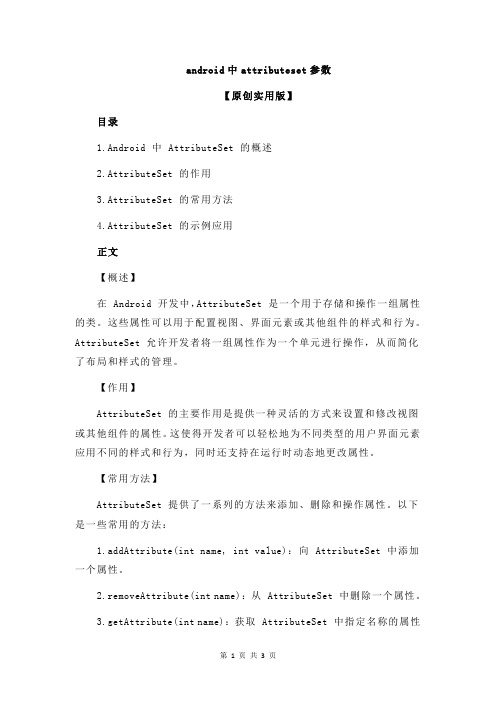
android中attributeset参数【原创实用版】目录1.Android 中 AttributeSet 的概述2.AttributeSet 的作用3.AttributeSet 的常用方法4.AttributeSet 的示例应用正文【概述】在 Android 开发中,AttributeSet 是一个用于存储和操作一组属性的类。
这些属性可以用于配置视图、界面元素或其他组件的样式和行为。
AttributeSet 允许开发者将一组属性作为一个单元进行操作,从而简化了布局和样式的管理。
【作用】AttributeSet 的主要作用是提供一种灵活的方式来设置和修改视图或其他组件的属性。
这使得开发者可以轻松地为不同类型的用户界面元素应用不同的样式和行为,同时还支持在运行时动态地更改属性。
【常用方法】AttributeSet 提供了一系列的方法来添加、删除和操作属性。
以下是一些常用的方法:1.addAttribute(int name, int value):向 AttributeSet 中添加一个属性。
2.removeAttribute(int name):从 AttributeSet 中删除一个属性。
3.getAttribute(int name):获取 AttributeSet 中指定名称的属性值。
4.hasAttribute(int name):检查 AttributeSet 中是否存在指定名称的属性。
5.getAttributeNames():获取 AttributeSet 中所有属性的名称列表。
6.clear():清空 AttributeSet 中的所有属性。
【示例应用】下面是一个使用 AttributeSet 为 TextView 设置样式的示例:```java// 创建一个 AttributeSet 实例AttributeSet attrs = new AttributeSet();// 设置文本颜色attrs.addAttribute(android.R.attr.textColor,android.R.color.black);// 设置字体大小attrs.addAttribute(android.R.attr.textSize,android.R.dimen.text_size_14);// 设置字体样式attrs.addAttribute(android.R.attr.fontFamily,android.R.font.bold);// 为 TextView 设置 AttributeSetTextView textView = new TextView(this);textView.setAttributes(attrs);```在这个示例中,我们创建了一个 AttributeSet 实例,并使用addAttribute() 方法设置了文本颜色、字体大小和字体样式。
__attribute__()用法

__attribute__()用法一、概述在编程中,我们常常会使用各种修饰符来改变代码的行为。
而在C语言中,使用`__at tri b ut e__()`函数,我们可以更加灵活地对函数、变量、类型等进行修饰,以达到特定的目的。
本文将介绍`__a tt ri bu te__()`的基本语法和常见用法。
二、基本语法`__a tt ri bu te__()`函数的基本语法如下:__at tr ib ut e__((at t ri bu te-l is t))其中,`at tr ib ut e-l is t`是一个由多个属性参数构成的逗号分隔列表。
每个属性参数使用双下划线`__`包围,属性参数的取值可以是一个或多个,用于指定相应的修饰符。
三、常见用法1.函数属性1.1优化级别通过`__a tt ri bu te__`函数,我们可以指定函数的优化级别,让编译器对函数进行特定的优化处理。
例如:v o id__at tr ib ut e__((o pt im iz e("O2")))m yF un ct io n(){//函数体}在上述示例中,我们指定了函数`my Fu nct i on()`的优化级别为O2,表示使用较高的优化级别对其进行编译。
1.2内联函数使用`__a tt ri bu te__`函数,我们可以将函数声明为内联函数,以提高函数调用的效率。
例如:i n li ne vo id__at tri b ut e__((a lw ay s_i n li ne))my Fu nc tio n(){//函数体}上述代码中,我们将函数`m yF un ct io n()`声明为内联函数,并使用`a lw ay s_in li ne`属性参数,确保该函数总是内联展开。
2.变量属性2.1对齐方式使用`__a tt ri bu te__`函数,我们可以指定变量的对齐方式,以满足特定的内存对齐需求。
__attribute__用法

__attribute__用法在C语言中,__attribute__是一种特殊的语法,用于给函数、变量、结构体等对象添加属性。
它可以用于告诉编译器一些额外的信息,帮助编译器进行优化或者进行静态检查。
在本文中,我们将对__attribute__的使用方法进行详细解析,并介绍一些常用的属性。
1. __attribute__((packed))__attribute__((packed))可以用于结构体或者联合体,它告诉编译器不要对结构体进行字节对齐。
在默认情况下,编译器会对结构体进行字节对齐,以提高读写效率。
但是在一些特殊情况下,我们需要按照实际占用的字节数来定义结构体,这时就可以使用packed属性。
例如,我们定义一个结构体来表示一个位域:```struct BitField {unsigned int a : 1;unsigned int b : 2;unsigned int c : 3;} __attribute__((packed));```在上面的例子中,由于使用了packed属性,结构体BitField的大小将是6个字节,而不是按照默认的对齐方式4个字节。
2. __attribute__((aligned(n)))__attribute__((aligned(n)))可以用于变量或者结构体,它告诉编译器将对象对齐到n字节边界。
默认情况下,编译器会按照最大基本类型的大小进行对齐,例如int型变量会按照4字节对齐。
例如,我们定义一个变量,并要求将其对齐到8字节边界:```int var __attribute__((aligned(8)));```在上面的例子中,变量var将被对齐到8字节边界。
3. __attribute__((noreturn))__attribute__((noreturn))用于告诉编译器一个函数不会返回。
这对于一些特殊的函数非常有用,如exit函数、abort函数等。
前端attribute的用法

一、介绍前端attribute的概念前端attribute是指前端开发中用来定义和控制HTML元素的属性,包括常见的class、id、style等。
在前端开发中,正确使用attribute 可以提高页面的可读性和效率,同时也可以使代码更加规范和易于维护。
二、常见的前端attribute及其用法1. classclass是用来给HTML元素定义一个或多个类名。
通过定义class,可以为元素统一设置样式,并且可以通过CSS选择器来选择这些元素。
2. idid是用来给HTML元素定义一个唯一的标识符。
通过定义id,可以在JavaScript中使用getElementById()方法来获取元素,从而实现对元素的操作。
3. stylestyle属性用来为元素直接设置样式,包括颜色、背景、边框等。
虽然可以通过CSS文件来设置样式,但在一些特殊情况下,使用style属性可以达到更灵活和精确的效果。
4. data-*data-*属性是HTML5新增的属性,用来在HTML元素上存储自定义数据。
通过data-*属性,可以在元素上存储一些与页面交互相关的数据,方便JavaScript操作。
5. href、src等除了上述常见的属性外,还有一些特定类型的attribute,比如a元素的href属性、img元素的src属性等,它们用来指定信息的目标和图片的路径。
三、前端attribute的最佳实践1. 合理使用class和id在编写HTML元素时,应该合理使用class和id。
class应该用来表示元素的共同特性,id应该用来表示元素的唯一标识。
应该避免给元素使用过多的class和id,以免导致代码过于复杂和混乱。
2. 优先使用外部样式表在设置元素的样式时,应该优先使用外部样式表,而不是在元素上使用style属性。
这样可以更好地实现样式和内容的分离,便于管理和修改样式。
3. 合理使用data-*属性在需要在页面上存储一些自定义数据时,应该合理使用data-*属性。
JS Attribute属性操作详解_
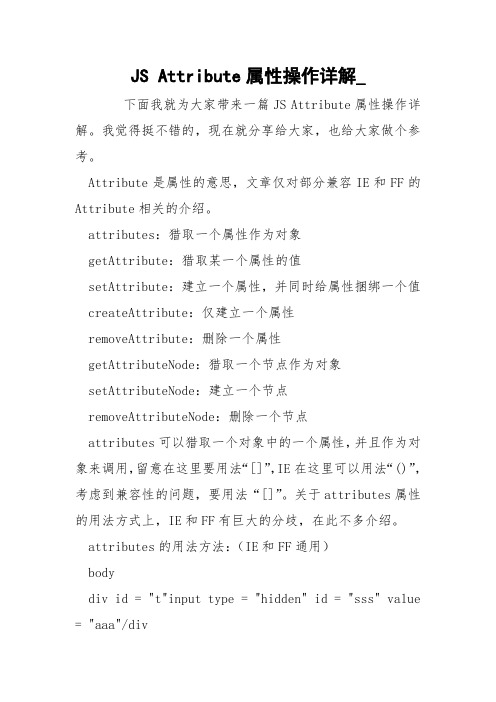
JS Attribute属性操作详解_下面我就为大家带来一篇JS Attribute属性操作详解。
我觉得挺不错的,现在就分享给大家,也给大家做个参考。
Attribute是属性的意思,文章仅对部分兼容IE和FF的Attribute相关的介绍。
attributes:猎取一个属性作为对象getAttribute:猎取某一个属性的值setAttribute:建立一个属性,并同时给属性捆绑一个值 createAttribute:仅建立一个属性removeAttribute:删除一个属性getAttributeNode:猎取一个节点作为对象setAttributeNode:建立一个节点removeAttributeNode:删除一个节点attributes可以猎取一个对象中的一个属性,并且作为对象来调用,留意在这里要用法“[]”,IE在这里可以用法“()”,考虑到兼容性的问题,要用法“[]”。
关于attributes属性的用法方式上,IE和FF有巨大的分歧,在此不多介绍。
attributes的用法方法:(IE和FF通用)bodydiv id = "t"input type = "hidden" id = "sss" value = "aaa"/div/bodyscriptvar d = document.getElementById("sss").attributes["value"]; document.write();document.write(d.value);//显示value aaa/scriptgetAttribute,setAttribute,createAttribute,removeAttribute四兄弟的概念比较简单理解,用法方法也比较简洁,唯一需要留意这几点:1、createAttribute在用法的时候不需要基于对象的,document.createAttribute()就可以。
C语言中__attribute__的用法
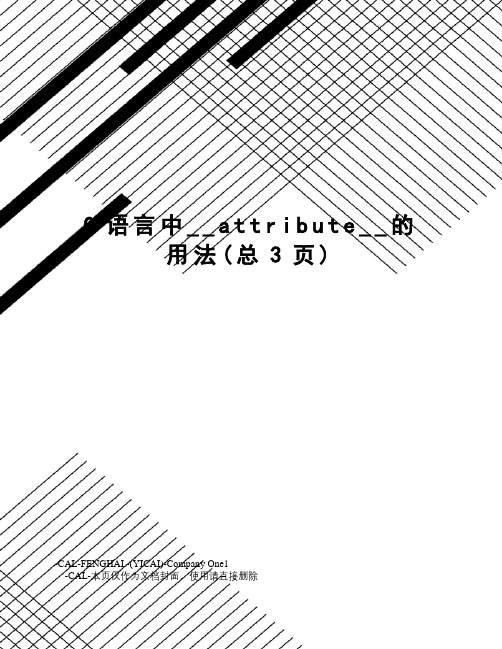
C语言中__a t t r i b u t e__的用法(总3页)-CAL-FENGHAI.-(YICAI)-Company One1-CAL-本页仅作为文档封面,使用请直接删除__a t t r i b u t e__机制GNU C的一大特色(却不被初学者所知)就是__attribute__机制。
__attribute__可以设置函数属性(Function Attribute)、变量属性(Variable Attribute)和类型属性(Type Attribute)。
__attribute__书写特征是:__attribute__前后都有两个下划线,并切后面会紧跟一对原括弧,括弧里面是相应的__attribute__参数。
__attribute__语法格式为:__attribute__ ((attribute-list))其位置约束为:放于声明的尾部“;”之前。
函数属性(Function Attribute)函数属性可以帮助开发者把一些特性添加到函数声明中,从而可以使编译器在错误检查方面的功能更强大。
__attribute__机制也很容易同非GNU应用程序做到兼容之功效。
GNU CC需要使用–Wall编译器来击活该功能,这是控制警告信息的一个很好的方式。
下面介绍几个常见的属性参数。
__attribute__ format该__attribute__属性可以给被声明的函数加上类似printf或者scanf的特征,它可以使编译器检查函数声明和函数实际调用参数之间的格式化字符串是否匹配。
该功能十分有用,尤其是处理一些很难发现的bug。
format的语法格式为:format (archetype, string-index, first-to-check)format属性告诉编译器,按照printf, scanf,strftime或strfmon的参数表格式规则对该函数的参数进行检查。
“archetype”指定是哪种风格;“string-index”指定传入函数的第几个参数是格式化字符串;“first-to-check”指定从函数的第几个参数开始按上述规则进行检查。
java中attribute的参数
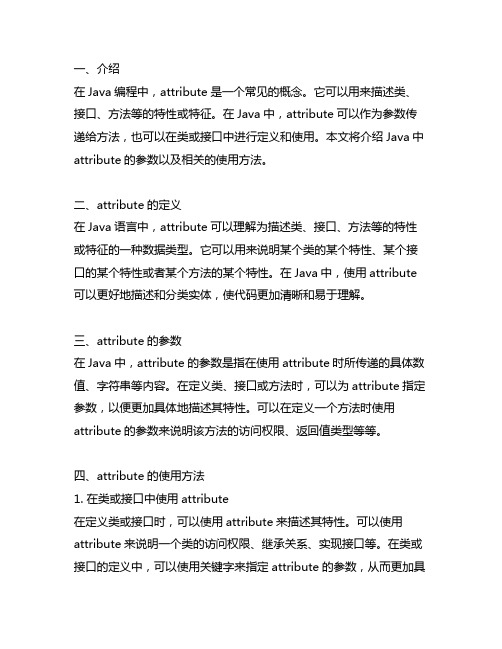
一、介绍在Java编程中,attribute是一个常见的概念。
它可以用来描述类、接口、方法等的特性或特征。
在Java中,attribute可以作为参数传递给方法,也可以在类或接口中进行定义和使用。
本文将介绍Java中attribute的参数以及相关的使用方法。
二、attribute的定义在Java语言中,attribute可以理解为描述类、接口、方法等的特性或特征的一种数据类型。
它可以用来说明某个类的某个特性、某个接口的某个特性或者某个方法的某个特性。
在Java中,使用attribute 可以更好地描述和分类实体,使代码更加清晰和易于理解。
三、attribute的参数在Java中,attribute的参数是指在使用attribute时所传递的具体数值、字符串等内容。
在定义类、接口或方法时,可以为attribute指定参数,以便更加具体地描述其特性。
可以在定义一个方法时使用attribute的参数来说明该方法的访问权限、返回值类型等等。
四、attribute的使用方法1. 在类或接口中使用attribute在定义类或接口时,可以使用attribute来描述其特性。
可以使用attribute来说明一个类的访问权限、继承关系、实现接口等。
在类或接口的定义中,可以使用关键字来指定attribute的参数,从而更加具体地描述该类或接口的特性。
2. 在方法中使用attribute在定义方法时,可以使用attribute来描述其特性。
可以使用attribute来说明一个方法的访问权限、返回值类型、参数列表等。
在方法的定义中,同样可以使用关键字来指定attribute的参数,从而更加具体地描述该方法的特性。
3. 传递attribute作为参数在调用方法时,可以将attribute作为参数传递给方法。
这样可以在方法的内部使用这些参数,从而实现更加灵活和通用的方法调用。
通过传递attribute作为参数,可以在不同的上下文中使用相同的方法,从而提高代码的复用性和可维护性。
js attributes用法
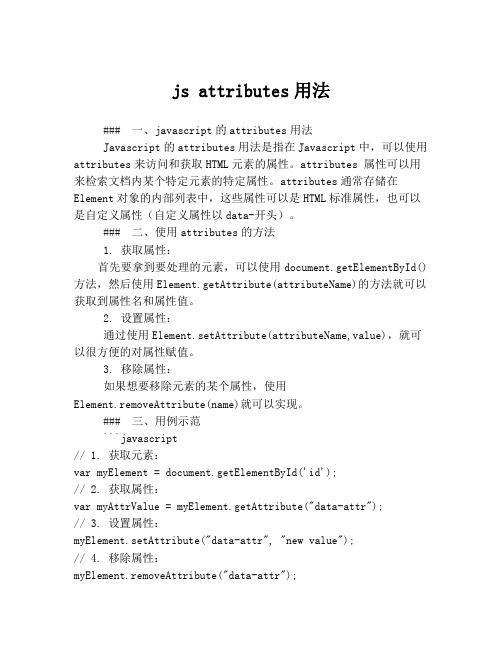
js attributes用法### 一、javascript的attributes用法Javascript的attributes用法是指在Javascript中,可以使用attributes来访问和获取HTML元素的属性。
attributes 属性可以用来检索文档内某个特定元素的特定属性。
attributes通常存储在Element对象的内部列表中,这些属性可以是HTML标准属性,也可以是自定义属性(自定义属性以data-开头)。
### 二、使用attributes的方法1. 获取属性:首先要拿到要处理的元素,可以使用document.getElementById()方法,然后使用Element.getAttribute(attributeName)的方法就可以获取到属性名和属性值。
2. 设置属性:通过使用Element.setAttribute(attributeName,value),就可以很方便的对属性赋值。
3. 移除属性:如果想要移除元素的某个属性,使用Element.removeAttribute(name)就可以实现。
### 三、用例示范```javascript// 1. 获取元素:var myElement = document.getElementById('id');// 2. 获取属性:var myAttrValue = myElement.getAttribute("data-attr");// 3. 设置属性:myElement.setAttribute("data-attr", "new value");// 4. 移除属性:myElement.removeAttribute("data-attr");```### 四、总结总之,attributes就是可以用来获取,设置,删除HTML元素属性的一个Javascript方法,它是DOM操作中很常用的一种,可以应用在DOM元素的属性值设置上,是很重要的一种技术。
32单片机attribute用法

32单片机attribute用法32单片机attribute用法单片机是企业、个人项目中常见的硬件系统之一。
有时候,仅仅通过硬件系统是难以完成某些功能,这时候就需要使用到软件技术。
在单片机的软件编程中,Attribute是一个非常重要的关键字。
Attribute可以被用来整理和管理程序代码,还可以优化单片机应用的效率。
一、Attribute是什么?Attribute可以被用来定义各种功能性标记和指向硬件资源的指令,请参见《Keil C51 目标通用指令集》和《Keil C51 扩展指令集》。
Attribute可以被用来定义变量、函数和程序代码段的属性。
二、Attribute可以用于定义哪些信息?Attribute可以被用于定义许多不同的信息,包括但不限于:1. 内存布局和分配。
2. 对于不同的片内外设的配置。
3. 关于函数和变量的优化级别。
4. 对于调试器、仿真器和强制电极的配置。
三、Attribute如何在程序中使用?Attribute关键字跟在C语言的类型之后,随后用括号括起来并加上一个或多个参数。
这些参数指定了当前变量、函数或代码段的属性。
如下所示:1. 对于结果类型的属性:uint32_t __attribute__((aligned(4))) data;2. 对于变量的属性:#define RAMSIZE 128uint8_t __attribute__((space(dmem))) buffer[RAMSIZE];3. 对于函数的属性:void __attribute__((interrupt(PERIPHERAL_1_VECTOR)))Peripheral1_Int(void);四、Attribute的应用使用Attribute可以优化程序的效率和内存占用,提高程序的可靠性和可移植性。
Attribute可以被用来优化变量、函数和代码段的属性。
优化可以带来许多好处,如:1. 减少代码的优化时间,提高程序的效率。
C#基础系列——Attribute特性使用
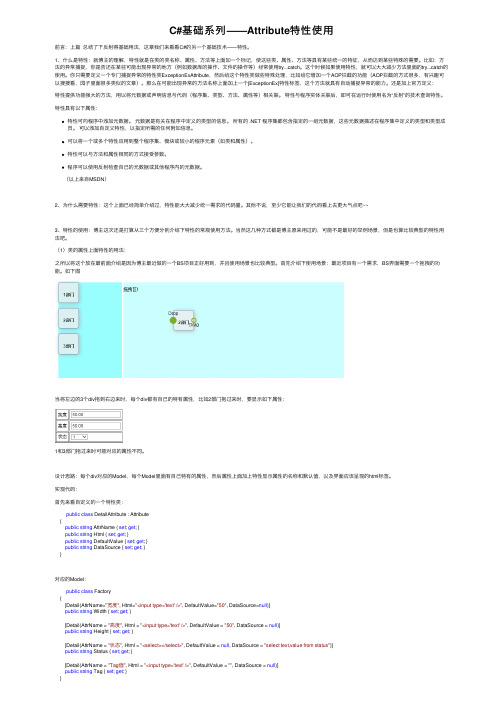
C#基础系列——Attribute特性使⽤前⾔:上篇总结了下反射得基础⽤法,这章我们来看看C#的另⼀个基础技术——特性。
1、什么是特性:就博主的理解,特性就是在类的类名称、属性、⽅法等上⾯加⼀个标记,使这些类、属性、⽅法等具有某些统⼀的特征,从⽽达到某些特殊的需要。
⽐如:⽅法的异常捕捉,你是否还在某些可能出现异常的地⽅(例如数据库的操作、⽂件的操作等)经常使⽤try...catch。
这个时候如果使⽤特性,就可以⼤⼤减少⽅法⾥⾯的try...catch的使⽤。
你只需要定义⼀个专门捕捉异常的特性类ExceptionExAttribute,然后给这个特性类做些特殊处理,⽐如给它增加⼀个AOP拦截的功能(AOP拦截的⽅式很多,有兴趣可以搜搜看,园⼦⾥⾯很多类似的⽂章)。
那么在可能出现异常的⽅法名称上⾯加上⼀个[ExceptionEx]特性标签,这个⽅法就具有⾃动捕捉异常的能⼒。
还是加上官⽅定义:特性提供功能强⼤的⽅法,⽤以将元数据或声明信息与代码(程序集、类型、⽅法、属性等)相关联。
特性与程序实体关联后,即可在运⾏时使⽤名为“反射”的技术查询特性。
特性具有以下属性:特性可向程序中添加元数据。
元数据是有关在程序中定义的类型的信息。
所有的 .NET 程序集都包含指定的⼀组元数据,这些元数据描述在程序集中定义的类型和类型成员。
可以添加⾃定义特性,以指定所需的任何附加信息。
可以将⼀个或多个特性应⽤到整个程序集、模块或较⼩的程序元素(如类和属性)。
特性可以与⽅法和属性相同的⽅式接受参数。
程序可以使⽤反射检查⾃⼰的元数据或其他程序内的元数据。
(以上来⾃MSDN)2、为什么需要特性:这个上⾯已经简单介绍过,特性能⼤⼤减少统⼀需求的代码量。
其他不说,⾄少它能让我们的代码看上去更⼤⽓点吧~~3、特性的使⽤:博主这次还是打算从三个⽅便分别介绍下特性的常规使⽤⽅法。
当然这⼏种⽅式都是博主原来⽤过的,可能不是最好的举例场景,但是也算⽐较典型的特性⽤法吧。
attribute造句简单
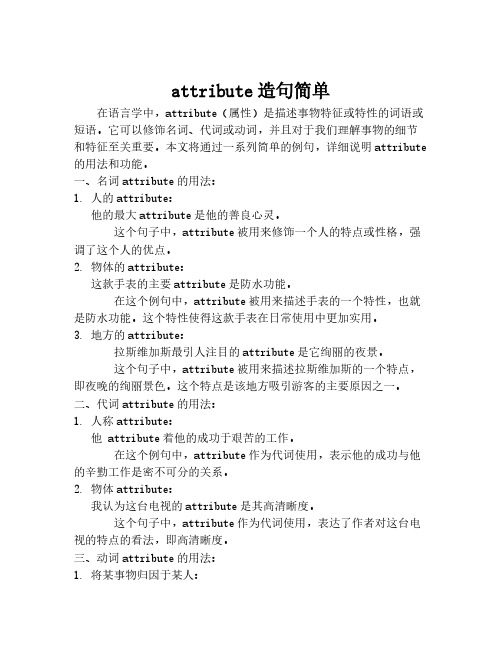
attribute造句简单 在语言学中,attribute(属性)是描述事物特征或特性的词语或短语。
它可以修饰名词、代词或动词,并且对于我们理解事物的细节和特征至关重要。
本文将通过一系列简单的例句,详细说明attribute 的用法和功能。
一、名词attribute的用法:1. 人的attribute:他的最大attribute是他的善良心灵。
这个句子中,attribute被用来修饰一个人的特点或性格,强调了这个人的优点。
2. 物体的attribute:这款手表的主要attribute是防水功能。
在这个例句中,attribute被用来描述手表的一个特性,也就是防水功能。
这个特性使得这款手表在日常使用中更加实用。
3. 地方的attribute: 拉斯维加斯最引人注目的attribute是它绚丽的夜景。
这个句子中,attribute被用来描述拉斯维加斯的一个特点,即夜晚的绚丽景色。
这个特点是该地方吸引游客的主要原因之一。
二、代词attribute的用法:1. 人称attribute:他 attribute着他的成功于艰苦的工作。
在这个例句中,attribute作为代词使用,表示他的成功与他的辛勤工作是密不可分的关系。
2. 物体attribute:我认为这台电视的attribute是其高清晰度。
这个句子中,attribute作为代词使用,表达了作者对这台电视的特点的看法,即高清晰度。
三、动词attribute的用法:1. 将某事物归因于某人: 人们常常将发明电灯泡的荣誉归attribute于托马斯·爱迪生。
在这个例句中,attribute作为动词使用,表示人们普遍认为发明电灯泡的功劳应归功于托马斯·爱迪生。
2. 将某事物归因于某因素: 他们将这次商店成功的归attribute于合适的推广策略。
这个句子中,attribute作为动词使用,表示商店成功的原因被归功于合适的推广策略。
attribute翻译
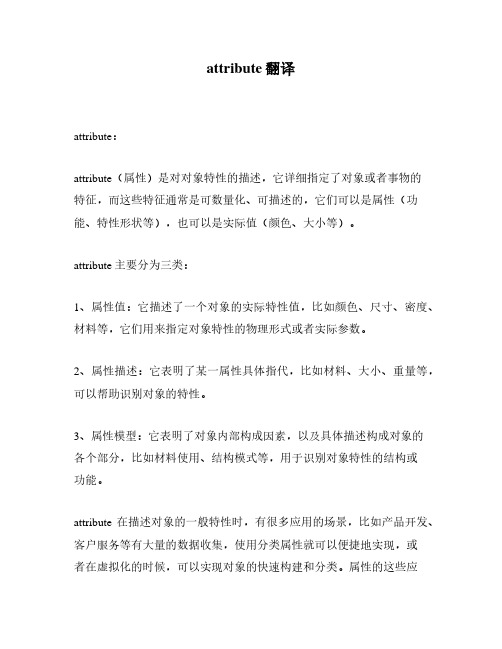
attribute翻译
attribute:
attribute(属性)是对对象特性的描述,它详细指定了对象或者事物的
特征,而这些特征通常是可数量化、可描述的,它们可以是属性(功能、特性形状等),也可以是实际值(颜色、大小等)。
attribute主要分为三类:
1、属性值:它描述了一个对象的实际特性值,比如颜色、尺寸、密度、材料等,它们用来指定对象特性的物理形式或者实际参数。
2、属性描述:它表明了某一属性具体指代,比如材料、大小、重量等,可以帮助识别对象的特性。
3、属性模型:它表明了对象内部构成因素,以及具体描述构成对象的
各个部分,比如材料使用、结构模式等,用于识别对象特性的结构或
功能。
attribute在描述对象的一般特性时,有很多应用的场景,比如产品开发、客户服务等有大量的数据收集,使用分类属性就可以便捷地实现,或
者在虚拟化的时候,可以实现对象的快速构建和分类。
属性的这些应
用,通常可以以一种简单的方式完成,可以节省时间,让工作更加有效率。
总而言之,attribute(属性)是一种定义对象特性的方式,它能帮助方便、快速地定义对象特征,更好地改善工作效率,进而获取更准确的结果。
sql中attribute函数的用法
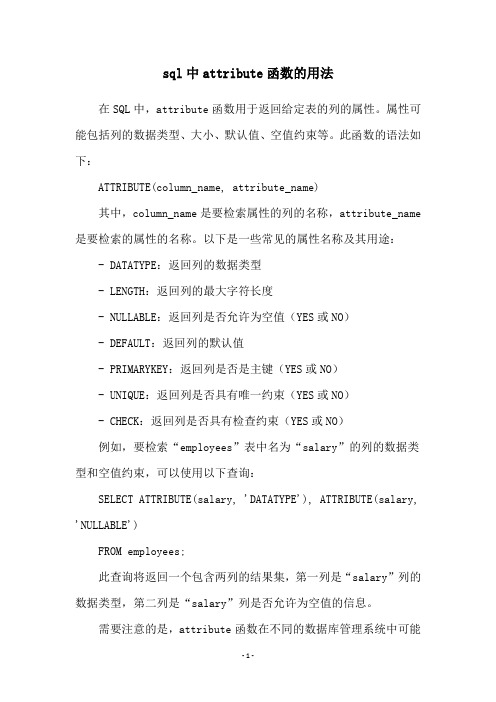
sql中attribute函数的用法
在SQL中,attribute函数用于返回给定表的列的属性。
属性可能包括列的数据类型、大小、默认值、空值约束等。
此函数的语法如下:
ATTRIBUTE(column_name, attribute_name)
其中,column_name是要检索属性的列的名称,attribute_name 是要检索的属性的名称。
以下是一些常见的属性名称及其用途:
- DATATYPE:返回列的数据类型
- LENGTH:返回列的最大字符长度
- NULLABLE:返回列是否允许为空值(YES或NO)
- DEFAULT:返回列的默认值
- PRIMARYKEY:返回列是否是主键(YES或NO)
- UNIQUE:返回列是否具有唯一约束(YES或NO)
- CHECK:返回列是否具有检查约束(YES或NO)
例如,要检索“employees”表中名为“salary”的列的数据类型和空值约束,可以使用以下查询:
SELECT ATTRIBUTE(salary, 'DATATYPE'), ATTRIBUTE(salary, 'NULLABLE')
FROM employees;
此查询将返回一个包含两列的结果集,第一列是“salary”列的数据类型,第二列是“salary”列是否允许为空值的信息。
需要注意的是,attribute函数在不同的数据库管理系统中可能
有所不同,具体语法和属性名称可能会有所不同。
因此,在使用此函数时,应仔细查阅相关文档并了解所使用的数据库管理系统的具体用法。
- 1、下载文档前请自行甄别文档内容的完整性,平台不提供额外的编辑、内容补充、找答案等附加服务。
- 2、"仅部分预览"的文档,不可在线预览部分如存在完整性等问题,可反馈申请退款(可完整预览的文档不适用该条件!)。
- 3、如文档侵犯您的权益,请联系客服反馈,我们会尽快为您处理(人工客服工作时间:9:00-18:30)。
ObjectCaptionFormatAttribute
AggregatedAttribute
在XPCollection<T>类型的属性上面写,可以控制主从表结构的业务对是否为聚合关系. 什么聚合?就是主对象与子对象放到一起对应着业务上的一个内容,比如,订单,订单明细,这两个表放到一起才是完整的.
CalculatedAttribute
在属性上面写,属性的结果将是计算而来的.
ExpandObjectMembersAttribute
写在复杂类型的属性上面,可以将属性类型中的属性展开,在视图上直接显示出来.比如,客户.地址.详细地址,与详细地址同级别的还有一堆的属性,用了这个后就可以一次性的显示出来了.
FieldSizeAttribute
字符型属性在库中建立字段时的长度,-1为不限长.
DefaultClassOptionsAttribute
加上这个后,BO就在导航栏上出现了,快速新建按钮也有了,报表中也会出现,我只观察到了这么多,这个就是个快捷方式.
DefaultListViewOptionsAttribute
在BO上面写,一些常见的默认列表视图的控制.
DelayedAttribute
ImmediatePostDataAttribute
在web下面有用,写在属性上,指示当值发生变化时,是否需要回发到服务端,比如, 总价=单价*数量,那么,单位,数量变化时,总价需要做个计算,那么就要在单价,数量上面加上这个Attribute.
IndexAttribute
在属性上面写,建表时,建个索引出来,为性能捉想.
你也可以使用一些属性是.net提供的(比如BrowsableAttribute,DefaultPropertyAttributeDisplayNameAttribute)
下面的列表是在ponentModel命名空间下的,在XAF中他们是有效的.
在属性上写,延迟加载该属性.官方说是EF用的.但我在xpo中也用过啊!
DetailViewLayoutAttribute
在属性上写,供在BO上对详细视图进行简单的布局.
DomainComponentAttribute
在接口上写,表明这是一个DC,在非持久化的BO上面写,表明让系统生成这个BO的视图.
ModelNodesGeneratorAttribute
自己写个类,是生成模型的,需要加这个.具体还是需要好几步的.
NavigationItemAttribute
某个BO是否显示在导航栏中.
NonCloneableAttribute
克隆模块:不允许这个BO克隆.
NotClonedInfoAttribute
ModelDefaultAttribute
在代码中写ModelEditor中的默认值,很多东东可以用这个设置了,并且可以替换掉一些前面的属性,比如本来可以用[XafDisplayName("显示名")]改为[ModelDefault("Caption","显示名")].至于Caption这个关键字要怎样知道,可以打开ModelDeditor查看.
说明
ActionAttribute
在业务对象上书写方法,并在方法上面加上这个Attribute,在界面上,会出现一个简单按钮或弹出窗口按钮.
AppearanceAttribute
在业务类或方法\属性上面书写此Attribute,可以控制相关的外观控制,比如:控件是否禁用,是否只读,背景颜色变化,字体,按钮是否可用等.
ImageEditorAttribute
图像编辑器的一些设置.
ImageNameAttribute
写在BO上面,设置一个图标,在列表上,详细视图上,都可以看到这个图标.
ImagesForBoolValuesAttribute
写在布尔型属性上面,可以指定布尔型值的图标,比如true用一个对号,false用一个叉叉.
CriteriaOptionsAttribute
当使用条件编辑器时,在这里指定一些选项,比如,条件应用到哪个BO上面.
DataSourceCriteriaAttribute
可以应用于BO类型的属性,或XPCollection<T>上面,指定选择(Link,链接)对象时,用什么条件去过滤数据源,比如,有个客户属性,选择客户时,某一场景中需要显示出所有年龄在30到50中间的客户.
VisibleInDetailViewAttribute
属性在详细视图中是否可见
VisibleInListViewAttribute
属性在列表视图中是否可见
VisibleInLookupListViewAttribute
属性在搜索视图中是否可见.
VisibleInReportsAttribute
做报表时是否可以选择这个BO.
XAF应用开发教程-内置Attribute功能列表
在XAF框架,一些用来生成一个业务应用程序的信息是在Attribute中指定。您可以将属性应用到业务类(或它的成员)指定验证规则,指定如何对数据进行显示、设置关系类等。本主题提供了有关在何处以及如何可以应用这些属性的内置XAF框架属性和信息的列表。
Attribute
DataSourceCriteriaPropertyAttribute
与上面的功能相同,但这个条件不是写死的,是从另一个属性中读过来的.这样可以在那个属性中动态的接出条件来.
DataSourcePropertyAttribute
功能与上面两个类型,但直接从某个属性中指定可选择的数据来源了,更加动态了,不过要考虑性能问题还是少用为好,因为程序员拼出来的数据源,说不准怎么来的.
XafDefaultPropertyAttribute
默认属性,在引用类型被用于属性时,用该引用类的哪个字段做为显示标题. 比如,订单中的客户,选择完成后,应该显示客户姓名,那么[XafDefaultPropety("姓名")]写在客户BO上面即可.
XafDisplayNameAttribute
指定显示名称,比如BO叫Customer,[XafDisplayName("客户")],写到BO上面.
CaptionsForBoolValuesAttribute
在布尔类型的属性上面写,可以指定true,false的值显示为指定的值,比如,换成男/女,真/假,是/否.但不要把这个做为汉化之用.
CodeRuleAttribute
Applied to a validation rule. Specifies that the rule is intended for a particular business class and does not have a corresponding validation attribute.
CollectionSourceModeAttribute
Specifies the mode of operation for the Collection Sources created by List Property Editors representing theCollectionSourceModeAttribute'starget property.
RuleCriteriaAttribute, 在类上面,数据必须满足指定的条件.
RuleFromBoolPropertyAttribute, 在布尔型属性上面,值必须为真.
RuleOLeabharlann jectExistsAttribute, 指定的对象必须存在.
RuleRangeAttribute, 属性的值必须在指定的范围内.
RuleCriteriaAttribute,
RuleFromBoolPropertyAttribute,
RuleIsReferencedAttribute,
RuleObjectExistsAttribute,
RuleRangeAttribute,
RuleRegularExpressionAttribute,
属性的提示文字.
ViewItemAttribute
Applied to a customView Item. Registers a View Item in an application and specifies the type of theApplication Model's node used by a custom View Item.
指示在详细视图中Bo的显示标题
PropertyEditorAttribute
要使用什么编辑器,默认都是自动的,只有想改变默认时才用这个.
Attributes from theValidationmodule:
RuleBaseAttribute,
RuleCombinationOfPropertiesIsUniqueAttribute,
KeyAttribute
写在属性上面,指示这个属性就是主键.
ListEditorAttribute
指定要使用的列表控件.
ListViewFilterAttribute
给列表内置一些过滤条件,在界面上显示一个下拉框,一选,就过滤啦.
LookupEditorModeAttribute
指示搜索对话框长什么样子,比如全部显示在下拉框中,或是弹出个窗口,或是自动,自动是指超过25条(可改)则显示弹出框.自动会有些性能影响,因为要算当前有多少条数据.
